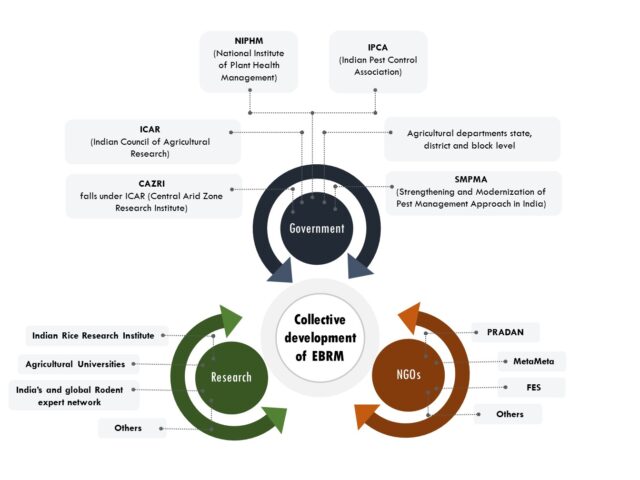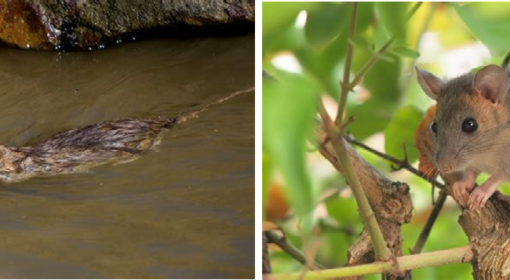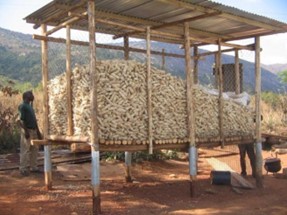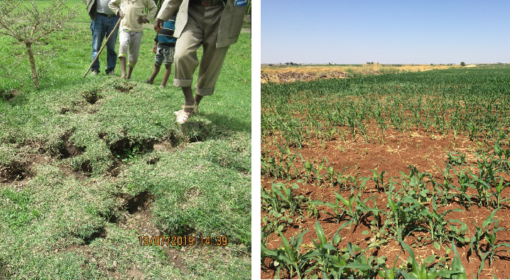Authors: Dr. Neena Singla (Punjab Agricultural University), Luwieke Bosma and Anushree Mitra (MetaMeta Research), and Dikhyani Konwar (PRADAN).
The issue of rodent damage in agricultural lands, affecting both pre- and post-harvest yields, continues to persist. Despite advancements in agricultural technology, farmers remain powerless against the threat of rats and mice. Theses rodents not only wreak havoc on agricultural produce (farmers report average damage of 25% in field and storage), but also contribute to the spread of diseases and the destruction of household items. Their impact is felt everywhere, be it rural or urban.
However, we do know a lot about these smart animals, we know about preventative measures that can greatly help farmers in India to improve the quantity and quality of their yields. There is a comprehensive set of measures that is coined Ecologically-Based Rodent Management (EBRM). EBRM is an eco-friendly approach to control rodents effectively, where traditional and modern methods are combined in one package.
This approach has great opportunity to be adopted in the states of Madhya Pradesh and Jharkhand in India, as the Adivasi people living in this tribal belt of India are well aware of the rodent species, their behaviour and their impact. However, recent modernization in agriculture, resulting in increased food and rice production, has attracted more and more rats hence increasing rat populations. This has led to farmers not able to manage rodents effectively by merely using the traditional methods. It requires more than that. EBRM presents this solution. It is built on 3 pillars: 1) collective effort, 2) timing and 3) combination of methods. These 3 pillars are essential for effective rodent control. Timing EBRM well, making it part of the standard rodent pest management procedure, and combining effective methods can truly make the difference.
The agricultural practices and natural resource management under EBRM may include:
- Weeds and grasses must be managed in the crop fields and peripheral surroundings to reduce hiding places and food options for rodents. So, by removing these from time to time, we can reduce attractiveness of fields to rodents thereby reducing their population in a particular area.
- Planting crops in lines and spacing between crop lines also helps to expose rats and limit their hiding places, thus reducing their movement options.
- Permanent bunds and water channels around the fields act as rodent reservoirs. Rodents live in these areas by making their permanent burrows and from here they can migrate to adjacent crop fields and cause damage. Rodents prefer to make burrows in bunds which are thick and high. Actions that should take place include: destroying burrows (especially before planting season) and reducing height and width of bunds (e.g. 1ft by 1ft).
- While irrigating crops, rodent burrows get flooded with water and rodents start coming out of their burrows. At that time, we can kill those animals coming out manually with sticks, trap them by setting traps and with the help of their natural enemies such as dogs, cats, owls etc.
- Farmers can be advised not to kill snakes, monitor lizards, mongoose, foxes, etc. in the fields, as these animals naturally help in controlling rodent population.
- Further, we can conserve the population of birds of prey like owls, eagles, kites etc. by installing artificial nest boxes suitable for these species, by installing T-shaped perches in the fields and by growing more of traditional trees which can be occupied by these birds.
- For post-harvest storage, traditional storage structures can be made rodent proof by including materials like tin and metal sheets, preventing entry of rodent and preventing them from climbing. Methods for doing so are available.
- The store house should be kept clean and without hiding places to reduce its attractiveness to rodents.
- We must ensure compatibility with new agronomic practices like mulching and zero tillage.
- Further, critical timings to start control operation in a particular crop, and collaboration with neighbouring farmers are also important.

EBRM can be integrated with (regenerative) agricultural practices and natural resource management. At the same time, EBRM offers opportunities for promoting livelihoods that stimulate the local economy. How do we see EBRM fitting into this?
Regenerative agriculture is all about increasing yields and healthier products, whilst ensuring the sustainable use of our natural resources. EBRM aims for just that and does so by providing alternative biological and ecological rodent management methods. These are a much-needed alternative to conventional chemical methods that cause harm to the environment and non-target species. EBRM is 100% chemical free, aims at prevention rather than killing and is based on robust knowledge of rat’s habitat and behaviour. By reducing rodent damage, we can increase yields and ensure higher quality and safety of crops by reducing rat-contamination.
In addition, different rat species have specific habitat preferences, they like stone bunds to take shelter, soft soils with high soil moisture to easily dig burrows and vegetative cover to hide for predators. Thus, a vibrant water catchment with healthy soils often means rats can also thrive. Therefore, it is important to figure out which rat habitat-functions we can control to reduce pest species to become abundant, while sustainable managing natural resources.
Lastly, there is ample opportunity to produce biological products which are 100% natural and have a 100% local value chain. Furthermore, there are opportunities for diverse people to innovate rodent-proof storage and provide EBRM services. Offering job opportunities for micro-enterprises, entrepreneurs and innovators; making rural economy lively again.
As one can see, EBRM fulfils a critical role in the entire rural development landscape and it offers opportunities for a diversity of residents. Figure 1 shows an overview of actors in India that are involved in pest management, these largely come from government, research institutions and NGOs.

All these actors have a role and responsibility in helping to develop the agricultural sector in India. For instance, National Institute of Plant Health Management (NIPHM) has developed training manuals and organises training programmes for stakeholders (farmers and staff) as well. The Agricultural University of Punjab has extensive expertise in the management of rodents in field, and is involved amongst others in monitoring and research on the different rodent species. PRADAN is building capacity with women self-help groups on regenerative agriculture, improving yields in a sustainable way and diversifying livelihood options.
Like we preach to communities to control rodents collectively, we must also come together to tackle this issue at scale in an integrated manner. Each organisation has important knowledge, skills and connections to bring in, that will greatly boost wide-scale uptake of EBRM. Making it an integral part of our work can take us the next mile and help many more farmers to effectively control rodents and improve food production.
Join hands with us and become an integral part of the EBRM movement to combat rodent impact on food production in India!
Reach out to Luwieke (lbosma@metameta.nl) or Anushree (amitra@metameta.nl) to get involved.




